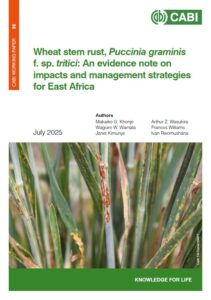Wheat stem rust, Puccinia graminis f. sp. tritici: An evidence note on impacts and management strategies for East Africa
Published: July, 2025
Working paper
Wheat is the second most cultivated cereal globally, and the second most important crop for human consumption after maize.
Wheat has become an important crop in Sub-Saharan Africa (SSA) where urbanization, nutrition transition and increasing population are the main driving factors. However, there is a growing gap between production (supply) and demand, particularly in East Africa (EA). Precisely, the imported wheat in Ethiopia, Kenya and Uganda stood at 28%, 75% and 95%, respectively over the period 1990–2021. These wheat production deficits mean that most countries in the region must spend their meagre resources on feeding their people. This evidence note explores wheat production issues within EA, with a focus on Ethiopia, Kenya and Uganda.
Among the biotic limitations, wheat stem rust (WSR), caused by Puccinia graminis f. sp. tritici is discussed in detail because currently it is the most devastating wheat disease. Wheat stem rust re-emerged in 1998 with the race Ug99 known to attack over 90% of the then released varieties of wheat worldwide. The epidemiology and its impact within EA and beyond is traced. To ensure food security, our review has found that substantial work championed by both international and national research organizations has been done on Ug99 management.
Recommendations for reducing the impact of Ug99 are made. Specifically, the use of cultural methods, biocontrol approaches, chemical use, breeding and promoting utilization of high yielding Ug99 resistant varieties and their complementary agronomic technologies can alleviate WSR demage. However, we also note that management of Ug99 is multifaceted and it requires multidisciplinary and multipronged approaches.

Wheat stem rust, Puccinia graminis f. sp. tritici: An evidence note on impacts and management strategies for East Africa
DOI https://dx.doi.org/10.1079/CABICOMM-62-8187
Type Working paper
Published in Working Paper 36
Language English
Year 2025
